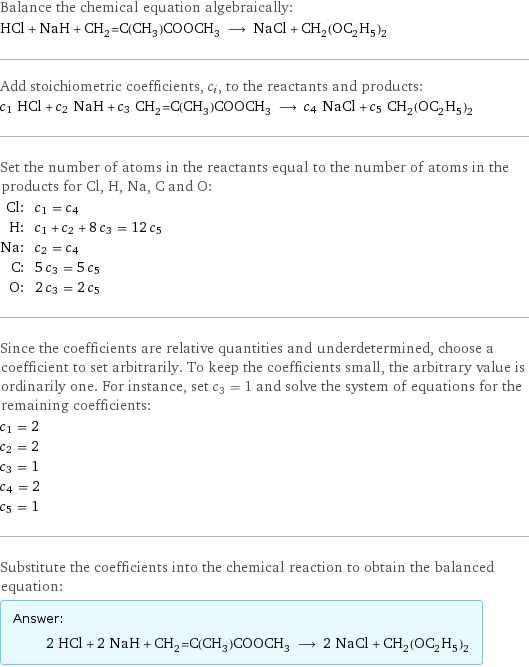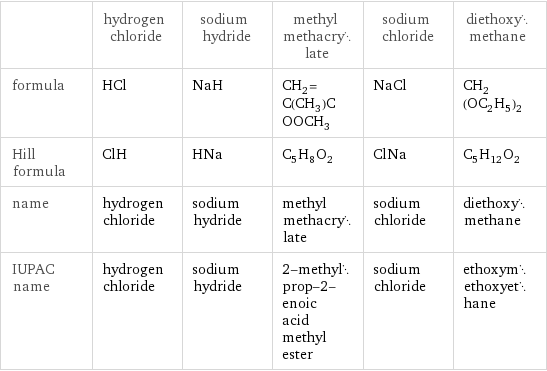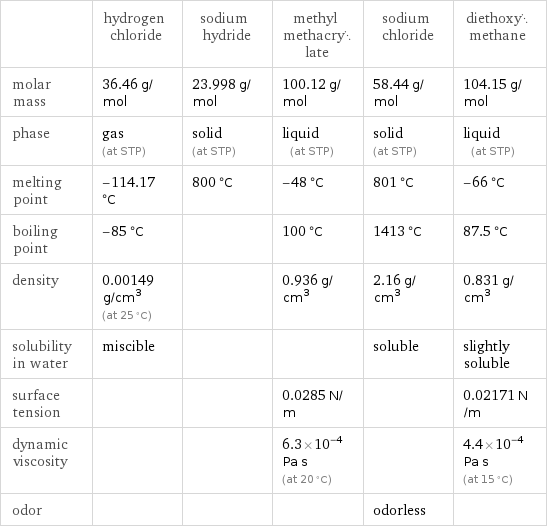Input interpretation

HCl hydrogen chloride + NaH sodium hydride + CH_2=C(CH_3)COOCH_3 methyl methacrylate ⟶ NaCl sodium chloride + CH_2(OC_2H_5)_2 diethoxymethane
Balanced equation

Balance the chemical equation algebraically: HCl + NaH + CH_2=C(CH_3)COOCH_3 ⟶ NaCl + CH_2(OC_2H_5)_2 Add stoichiometric coefficients, c_i, to the reactants and products: c_1 HCl + c_2 NaH + c_3 CH_2=C(CH_3)COOCH_3 ⟶ c_4 NaCl + c_5 CH_2(OC_2H_5)_2 Set the number of atoms in the reactants equal to the number of atoms in the products for Cl, H, Na, C and O: Cl: | c_1 = c_4 H: | c_1 + c_2 + 8 c_3 = 12 c_5 Na: | c_2 = c_4 C: | 5 c_3 = 5 c_5 O: | 2 c_3 = 2 c_5 Since the coefficients are relative quantities and underdetermined, choose a coefficient to set arbitrarily. To keep the coefficients small, the arbitrary value is ordinarily one. For instance, set c_3 = 1 and solve the system of equations for the remaining coefficients: c_1 = 2 c_2 = 2 c_3 = 1 c_4 = 2 c_5 = 1 Substitute the coefficients into the chemical reaction to obtain the balanced equation: Answer: | | 2 HCl + 2 NaH + CH_2=C(CH_3)COOCH_3 ⟶ 2 NaCl + CH_2(OC_2H_5)_2
Structures

+ + ⟶ +
Names

hydrogen chloride + sodium hydride + methyl methacrylate ⟶ sodium chloride + diethoxymethane
Equilibrium constant
![Construct the equilibrium constant, K, expression for: HCl + NaH + CH_2=C(CH_3)COOCH_3 ⟶ NaCl + CH_2(OC_2H_5)_2 Plan: • Balance the chemical equation. • Determine the stoichiometric numbers. • Assemble the activity expression for each chemical species. • Use the activity expressions to build the equilibrium constant expression. Write the balanced chemical equation: 2 HCl + 2 NaH + CH_2=C(CH_3)COOCH_3 ⟶ 2 NaCl + CH_2(OC_2H_5)_2 Assign stoichiometric numbers, ν_i, using the stoichiometric coefficients, c_i, from the balanced chemical equation in the following manner: ν_i = -c_i for reactants and ν_i = c_i for products: chemical species | c_i | ν_i HCl | 2 | -2 NaH | 2 | -2 CH_2=C(CH_3)COOCH_3 | 1 | -1 NaCl | 2 | 2 CH_2(OC_2H_5)_2 | 1 | 1 Assemble the activity expressions accounting for the state of matter and ν_i: chemical species | c_i | ν_i | activity expression HCl | 2 | -2 | ([HCl])^(-2) NaH | 2 | -2 | ([NaH])^(-2) CH_2=C(CH_3)COOCH_3 | 1 | -1 | ([CH2=C(CH3)COOCH3])^(-1) NaCl | 2 | 2 | ([NaCl])^2 CH_2(OC_2H_5)_2 | 1 | 1 | [CH2(OC2H5)2] The equilibrium constant symbol in the concentration basis is: K_c Mulitply the activity expressions to arrive at the K_c expression: Answer: | | K_c = ([HCl])^(-2) ([NaH])^(-2) ([CH2=C(CH3)COOCH3])^(-1) ([NaCl])^2 [CH2(OC2H5)2] = (([NaCl])^2 [CH2(OC2H5)2])/(([HCl])^2 ([NaH])^2 [CH2=C(CH3)COOCH3])](../image_source/0c51f3041c6528fe504913f21dbec402.png)
Construct the equilibrium constant, K, expression for: HCl + NaH + CH_2=C(CH_3)COOCH_3 ⟶ NaCl + CH_2(OC_2H_5)_2 Plan: • Balance the chemical equation. • Determine the stoichiometric numbers. • Assemble the activity expression for each chemical species. • Use the activity expressions to build the equilibrium constant expression. Write the balanced chemical equation: 2 HCl + 2 NaH + CH_2=C(CH_3)COOCH_3 ⟶ 2 NaCl + CH_2(OC_2H_5)_2 Assign stoichiometric numbers, ν_i, using the stoichiometric coefficients, c_i, from the balanced chemical equation in the following manner: ν_i = -c_i for reactants and ν_i = c_i for products: chemical species | c_i | ν_i HCl | 2 | -2 NaH | 2 | -2 CH_2=C(CH_3)COOCH_3 | 1 | -1 NaCl | 2 | 2 CH_2(OC_2H_5)_2 | 1 | 1 Assemble the activity expressions accounting for the state of matter and ν_i: chemical species | c_i | ν_i | activity expression HCl | 2 | -2 | ([HCl])^(-2) NaH | 2 | -2 | ([NaH])^(-2) CH_2=C(CH_3)COOCH_3 | 1 | -1 | ([CH2=C(CH3)COOCH3])^(-1) NaCl | 2 | 2 | ([NaCl])^2 CH_2(OC_2H_5)_2 | 1 | 1 | [CH2(OC2H5)2] The equilibrium constant symbol in the concentration basis is: K_c Mulitply the activity expressions to arrive at the K_c expression: Answer: | | K_c = ([HCl])^(-2) ([NaH])^(-2) ([CH2=C(CH3)COOCH3])^(-1) ([NaCl])^2 [CH2(OC2H5)2] = (([NaCl])^2 [CH2(OC2H5)2])/(([HCl])^2 ([NaH])^2 [CH2=C(CH3)COOCH3])
Rate of reaction
![Construct the rate of reaction expression for: HCl + NaH + CH_2=C(CH_3)COOCH_3 ⟶ NaCl + CH_2(OC_2H_5)_2 Plan: • Balance the chemical equation. • Determine the stoichiometric numbers. • Assemble the rate term for each chemical species. • Write the rate of reaction expression. Write the balanced chemical equation: 2 HCl + 2 NaH + CH_2=C(CH_3)COOCH_3 ⟶ 2 NaCl + CH_2(OC_2H_5)_2 Assign stoichiometric numbers, ν_i, using the stoichiometric coefficients, c_i, from the balanced chemical equation in the following manner: ν_i = -c_i for reactants and ν_i = c_i for products: chemical species | c_i | ν_i HCl | 2 | -2 NaH | 2 | -2 CH_2=C(CH_3)COOCH_3 | 1 | -1 NaCl | 2 | 2 CH_2(OC_2H_5)_2 | 1 | 1 The rate term for each chemical species, B_i, is 1/ν_i(Δ[B_i])/(Δt) where [B_i] is the amount concentration and t is time: chemical species | c_i | ν_i | rate term HCl | 2 | -2 | -1/2 (Δ[HCl])/(Δt) NaH | 2 | -2 | -1/2 (Δ[NaH])/(Δt) CH_2=C(CH_3)COOCH_3 | 1 | -1 | -(Δ[CH2=C(CH3)COOCH3])/(Δt) NaCl | 2 | 2 | 1/2 (Δ[NaCl])/(Δt) CH_2(OC_2H_5)_2 | 1 | 1 | (Δ[CH2(OC2H5)2])/(Δt) (for infinitesimal rate of change, replace Δ with d) Set the rate terms equal to each other to arrive at the rate expression: Answer: | | rate = -1/2 (Δ[HCl])/(Δt) = -1/2 (Δ[NaH])/(Δt) = -(Δ[CH2=C(CH3)COOCH3])/(Δt) = 1/2 (Δ[NaCl])/(Δt) = (Δ[CH2(OC2H5)2])/(Δt) (assuming constant volume and no accumulation of intermediates or side products)](../image_source/9c54501394441cc2c83d914d01ea8146.png)
Construct the rate of reaction expression for: HCl + NaH + CH_2=C(CH_3)COOCH_3 ⟶ NaCl + CH_2(OC_2H_5)_2 Plan: • Balance the chemical equation. • Determine the stoichiometric numbers. • Assemble the rate term for each chemical species. • Write the rate of reaction expression. Write the balanced chemical equation: 2 HCl + 2 NaH + CH_2=C(CH_3)COOCH_3 ⟶ 2 NaCl + CH_2(OC_2H_5)_2 Assign stoichiometric numbers, ν_i, using the stoichiometric coefficients, c_i, from the balanced chemical equation in the following manner: ν_i = -c_i for reactants and ν_i = c_i for products: chemical species | c_i | ν_i HCl | 2 | -2 NaH | 2 | -2 CH_2=C(CH_3)COOCH_3 | 1 | -1 NaCl | 2 | 2 CH_2(OC_2H_5)_2 | 1 | 1 The rate term for each chemical species, B_i, is 1/ν_i(Δ[B_i])/(Δt) where [B_i] is the amount concentration and t is time: chemical species | c_i | ν_i | rate term HCl | 2 | -2 | -1/2 (Δ[HCl])/(Δt) NaH | 2 | -2 | -1/2 (Δ[NaH])/(Δt) CH_2=C(CH_3)COOCH_3 | 1 | -1 | -(Δ[CH2=C(CH3)COOCH3])/(Δt) NaCl | 2 | 2 | 1/2 (Δ[NaCl])/(Δt) CH_2(OC_2H_5)_2 | 1 | 1 | (Δ[CH2(OC2H5)2])/(Δt) (for infinitesimal rate of change, replace Δ with d) Set the rate terms equal to each other to arrive at the rate expression: Answer: | | rate = -1/2 (Δ[HCl])/(Δt) = -1/2 (Δ[NaH])/(Δt) = -(Δ[CH2=C(CH3)COOCH3])/(Δt) = 1/2 (Δ[NaCl])/(Δt) = (Δ[CH2(OC2H5)2])/(Δt) (assuming constant volume and no accumulation of intermediates or side products)
Chemical names and formulas

| hydrogen chloride | sodium hydride | methyl methacrylate | sodium chloride | diethoxymethane formula | HCl | NaH | CH_2=C(CH_3)COOCH_3 | NaCl | CH_2(OC_2H_5)_2 Hill formula | ClH | HNa | C_5H_8O_2 | ClNa | C_5H_12O_2 name | hydrogen chloride | sodium hydride | methyl methacrylate | sodium chloride | diethoxymethane IUPAC name | hydrogen chloride | sodium hydride | 2-methylprop-2-enoic acid methyl ester | sodium chloride | ethoxymethoxyethane
Substance properties

| hydrogen chloride | sodium hydride | methyl methacrylate | sodium chloride | diethoxymethane molar mass | 36.46 g/mol | 23.998 g/mol | 100.12 g/mol | 58.44 g/mol | 104.15 g/mol phase | gas (at STP) | solid (at STP) | liquid (at STP) | solid (at STP) | liquid (at STP) melting point | -114.17 °C | 800 °C | -48 °C | 801 °C | -66 °C boiling point | -85 °C | | 100 °C | 1413 °C | 87.5 °C density | 0.00149 g/cm^3 (at 25 °C) | | 0.936 g/cm^3 | 2.16 g/cm^3 | 0.831 g/cm^3 solubility in water | miscible | | | soluble | slightly soluble surface tension | | | 0.0285 N/m | | 0.02171 N/m dynamic viscosity | | | 6.3×10^-4 Pa s (at 20 °C) | | 4.4×10^-4 Pa s (at 15 °C) odor | | | | odorless |
Units
